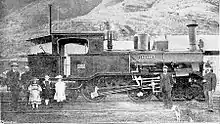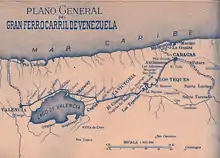Great Venezuela Railway
The Great Venezuela Railway (Gran Ferrocarril de Venezuela) was a 179-kilometre (111 mi) 3 ft 6 in (1,067 mm) railway from Caracas to Valencia. The railway was the longest in Venezuela. It proved difficult to recoup the initial investment and the railway became a notable cause of the Venezuelan crisis of 1902–1903. It fell into disrepair through the early 20th century and the last train ran in 1966.[1]


.jpg.webp)
Origin
Friedrich Krupp AG contracted with the Venezuelan government in 1888 to build the railway in exchange for £12,800 per kilometer to be repaid at 7 percent interest. Disconto-Gesellschaft financed the project; and terms were renegotiated at £11,000 per kilometer in 1891. The railway was completed in February 1894.[2]
Description
The railway replaced a difficult carriage road through mountainous terrain. Contemporary accounts expressed great praise for the construction, which used Krupp steel railroad ties.[3] The Caracas station was adjacent[4] to the 3 ft (914 mm) gauge railway to the coast at La Guaira (closed 1951).[5] The railway west entered the 285-metre (935 ft) Calvario tunnel for level grade to Antímano where a 2 percent climb began to a 1,227-metre (4,026 ft) summit in 267-metre (876 ft) Corozal tunnel 30 kilometres (19 mi) from Caracas. From Corozal tunnel the railway required 212 Krupp steel viaducts and 84 tunnels to cover 44 kilometres (27 mi) of gently descending grade across steep canyons to reach the fertile valley of Lake Valencia. The 106-metre (348 ft) viaduct over Agua Amarillo was the longest on the line and stood 47 metres (154 ft) above the water.[6] The Valencia terminus was at San Blas, but the line was eventually connected to the Puerto Cabello and Valencia railway which had its own terminus at Camoruco.
By 1922 the railway had 18 locomotives, 30 passenger cars, 68 flatcars, and 20 stock cars.[7] Although the 4-4-4T locos could reach 70 km/h (43 mph), trains took 7 hours for the 179 km.[8]
Financial difficulty
Early in the line's history it was adversely affected by political instability in Venezuela. Krupp computed Venezuela's debt (including damages arising from the revolution against Venezuelan president Raimundo Andueza Palacio) as £1,900,000. Suspension of debt payments by Cipriano Castro in 1901 was followed by the Venezuelan crisis of 1902–1903, a naval blockade involving gunboat diplomacy.[9]
Museum
The summit section of the railway forms part of a recreation park called Parque El Encanto (El Encanto is also the name of one of the stations). Work began in 2015 on a 350 million bolivar plan to restore 7 km (4.3 mi) of track as a heritage railway, with 7 tunnels and 5 bridges, providing for a 25-minute journey from Los Lagos to El Encanto.[10]
See also
References
- "The Tramways of Caracas Venezuela". Allen Morrison. Retrieved 2013-03-02.
- The Railway News volume 84 (26 August 1905) p.402
- Moore, Joseph Hampton (1907) With Speaker Cannon through the Tropics p.192
- "THE TRAMWAYS OF VENEZUELA". www.tramz.com. Retrieved 2017-01-05.
- "La Guaira and Caracas Railway". www.tramz.com. Retrieved 2017-01-06.
- United States Department of Commerce and Labor Consular Reports issues 196-199 (1897) Railroads of Venezuela pp.470-472
- Purl Lord Bell Venezuela, a Commercial and Industrial Handbook (1922) United States Government Printing Office p.127
- "The Great Venezuelan Railway". Railway Magazine. July 1901. pp. 38–48. Retrieved 2017-01-06.
- Tomz, Michael Enforcement by Gunboats Stanford University (2006) p.189
- "Parque Recreacional El Encanto recuperará su atractivo turístico". www.mintur.gob.ve. Archived from the original on 2017-01-06. Retrieved 2017-01-06.
External links
- Photobucket photos of the railway]
- Parque El Encanto museum photos]